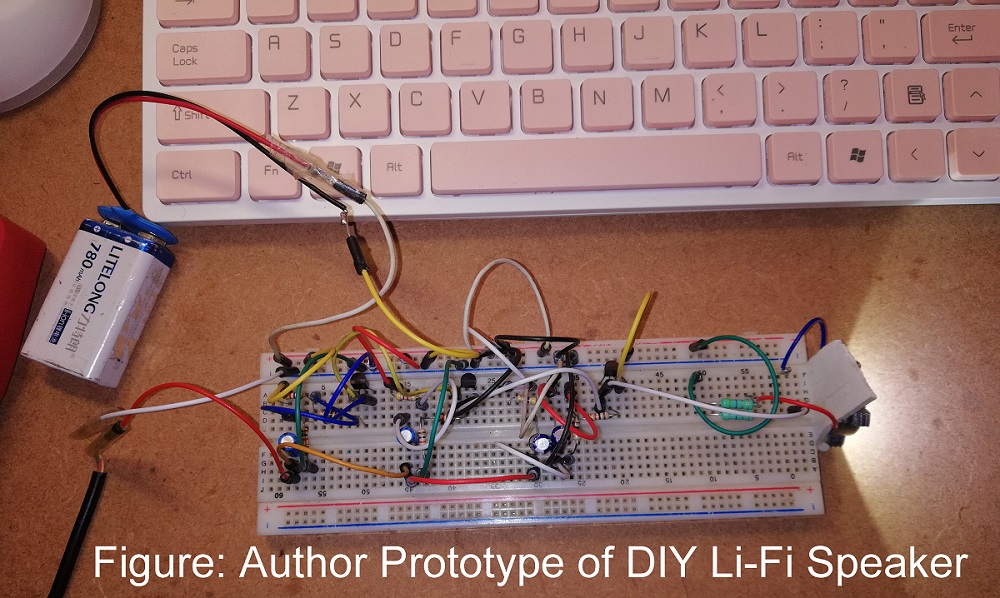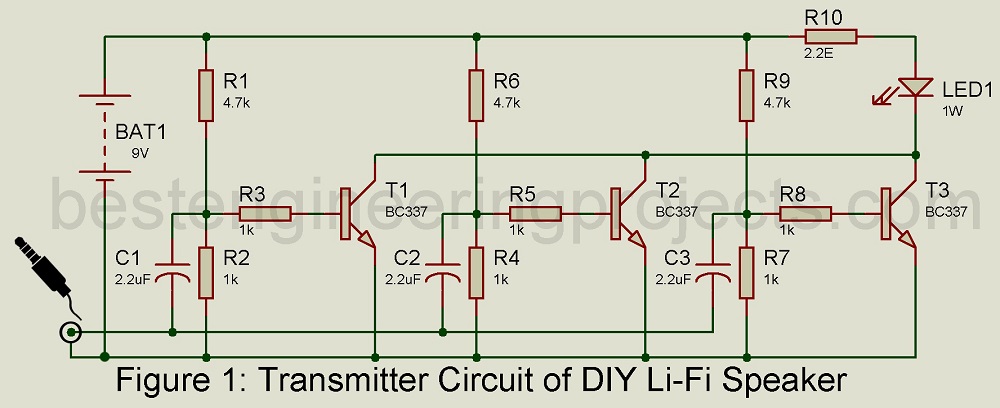Here in the article I am going to show you “How to design DIY Li-Fi speaker” we are going to show you how to make Li-Fi speaker i.e. uses light to transfer data. This article consist of entire detail like design procedure, circuit diagram, and description.
Introduction to Li-Fi (Light Fidelity)
The term wireless has been gaining so much popularity in the recent years. Li-Fi is another block to growing platform. The term Li-Fi; Light Fidelity sounds somehow similar to Wi-Fi and they share a lot of common features. Both are a means to transfer data electro-magnetically. The difference is that Li-Fi uses visible light for data transmission.
Li-Fi is best suited for high speed indoor transmissions and thus we have designed a Li-Fi transmitter and speaker circuit for audio and music applications. The concept of the project is to use Li-Fi technology to replace the conventional music systems based on lengthy wired speakers with the modernized Li-Fi dongle and speakers that use light to receive audio signals. Just like the amazing concept of this project, the economy of project development is also much less. The project can be made ready with a budget as low as $ 5.
The audio jack output of mobile phone is connected with the Li-Fi transmitter and here, audio signals are simultaneously converted into light signals which are transmitted by the LED in the Li-Fi transmitter circuit and received by the Li-Fi speaker as light signals. The speaker circuit is made up of solar cell array to trap light signals. Fig.2 shows the receiver circuit.
Circuit and working of DIY Li-Fi speaker
The transmitter circuit for Li-Fi speaker is given in fig.1. The transmitter circuit is made of three amplifiers. The audio signals from the mobile phone are further amplified by the common-emitter (CE) amplifiers configured in parallel mode. Now, talking about the Li-Fi speaker circuit, it is built around the solar cell array and an ordinary speaker. The 3V, 200mA solar cell array generates an output which is then fed as input to the audio port of the speaker as input. To establish this connection, you can employ a 3.5 mm female audio socket that connects the solar panel with the audio jack of speaker as shown in circuit diagram.
You are free to use any speaker, speakers have inbuilt amplifiers and they serve the same purpose. So, pick any speaker convenient to you. Just by interfacing with a solar panel, you can change any ordinary working speaker into a Li-Fi speaker. The quality of audio signals can be distorted and thus pay attention to the proper adjustment of band equalizer circuits in the audio source and the transmitter-receiver circuit to reduce noise in the audio signal obtained from the speaker.
Number of amplifier stages determine the proper distance at which Li-Fi speaker should be fixed at. For our project, maximum distance is approximately two meters with illuminance capacity of LED; 13,842.00 lux at the receiver circuit. With LED illuminance of 17,382.00 lux and five CE amplifiers, the distance expands to 2.6 meters. When we increase the number of amplifiers in parallel combination, the intensity of light also increased which lead to increase in the maximum distance available in between the transmitter and receiver circuit with a better sound quality.
The project can be implemented in so many ways, some of which are enlisted below:
- With the use of flashlight of camera, audio signals from different devices like a mobile phone, MP3 player, laptop, tablet can be wirelessly transmitted to Li-Fi speakers.
- In auditorium, audio signals can be transmitted to Li-Fi speakers on the dais. The pre-installed LED lights serve very well as a transmitter,
- We can play music in public vehicles like in buses, trains, cars and airplanes using reading lights.
The project can be implemented in areas with bright lights throughout the day like in offices, hotels, auditorium, etc. Initially, fix LED1 on the front side of the box. Establish the connection between the Li-Fi transmitter and any audio source such as mobile phone. The LED starts to glow as soon as the song is played. Adjust the transmitter circuit such that the light from the LED is focused on the solar panel. After this, the song is audible from the speaker. To improve the sound quality, adjust the distance between the transmitter and receiver section.
PARTS LIST OF DIY Li-Fi- SPEAKER
| Resistors (all ¼-watt, ± 5% Carbon) |
| R1, R6, R9 = 4.7 KΩ
R2 – R5, R8, R8 = 1 KΩ R10 = 2.2 Ω, 1 Watt |
| Capacitors |
| C1 – C3 = 2.2 µF, 25V (Electrolytic Capacitor) |
| Semiconductors |
| T1 – T3 = BC337 NPN Transistors
LED1 = 1W White LED |
| Miscellaneous |
| BATT. = 9V Battery
3V, 200mA solar panel Audio female jack Any speaker with inbuilt amplifier |



Thank you very much for sharing your knowledge! Instead of audio i wanted to send textmessages. Your post helped me a lot: https:// nerd-corner.com/sending-text-messages-with-visible-light-communication/